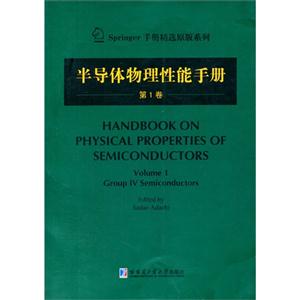-
>
公路车宝典(ZINN的公路车维修与保养秘籍)
-
>
晶体管电路设计(下)
-
>
基于个性化设计策略的智能交通系统关键技术
-
>
花样百出:贵州少数民族图案填色
-
>
山东教育出版社有限公司技术转移与技术创新历史丛书中国高等技术教育的苏化(1949—1961)以北京地区为中心
-
>
铁路机车概要.交流传动内燃.电力机车
-
>
利维坦的道德困境:早期现代政治哲学的问题与脉络
半导体物理性能手册-第1卷 版权信息
- ISBN:9787560345130
- 条形码:9787560345130 ; 978-7-5603-4513-0
- 装帧:一般胶版纸
- 册数:暂无
- 重量:暂无
- 所属分类:>>
半导体物理性能手册-第1卷 本书特色
《半导体物理性能手册(第1卷)(英文版)》系springer手册精选原版系列。《半导体物理性能手册(第1卷)(英文版)》主要包括diamond(c)、silicon(si)、germanium(c)、gray tin(a—sn)、cubic silicon carbide(3c—sic)、hexagonal silicon carbide(2h—,4h—,6h—sic,etc.)、rhombohedral silicon carbide(15r—,21r—,24r—sic,etc.)等内容。
半导体物理性能手册-第1卷 内容简介
足立贞夫所著的《半导体物理性能手册》介绍了各族半导体、化合物半导体的物理性能,包括:StructuralProperties结构特性ThermalProperties热学性质ElasticProperties弹性性质PhononsandLatticeVibronicProperties声子与晶格振动性质CollectiveEffectsandRelatedProperties集体效应及相关性质Energy-BandStructure:Energy-BandGaps能带结构:能带隙Energy-BandStructure:ElectronandHoleEffectiveMasses能带结构:电子和空穴的有效质量ElectronicDeformationPotential电子形变势ElectronAffinityandSchottkyBarrierHeight电子亲和能与肖特基势垒高度OpticalProperties光学性质Elastooptic,Electrooptic,andNonlinearOpticalProperties弹光、电光和非线性光学性质CartierTransportProperties载流子输运性质、适用对象包括材料、微电子学、电子科学与技术等专业的本科生和研究生,以及从事半导体研究的专业人员。
半导体物理性能手册-第1卷 目录
acknowledgments
contents of other volumes
1 diamond (c)
1.1 structural properties
1.1.1 ionicity
1.1.2 elemental isotopic abundance and molecular weight
1.1.3 crystal structure and space group
1.1.4 lattice constant and its related parameters
1.1.5 structural phase transition
1.1.6 cleavage plane
1.2 thermal properties
1.2.1 melting point and its related parameters
1.2.2 specific heat
1.2.3 debye temperature
1.2.4 thermal expansion coefficient
1.2.5 thermal conductivity and diffusivity
1.3 elastic properties
1.3.1 elastic constant
1.3.2 third—order elastic constant
1.3.3 young's modulus, poisson's ratio, and similar
1.3.4 microhardness
1.3.5 sound velocity
1.4 phonons and lattice vibronic properties
1.4.1 phonon dispersion relation
1.4.2 phonon frequency
1.4.3 mode gruneisen parameter
1.4.4 phonon deformation potential
1.5 collective effects and related properties
1.5.1 piezoelectric constant
1.5.2 frohlich coupling constant
1.6 energy—band structure: energy—band gaps
1.6.1 basic properties
1.6.2 e0—gap region
1.6.3 higher—lying direct gap
1.6.4 lowest indirect gap
1.6.5 conduction—valley energy separation
1.6.6 direct—indirect—gap transition pressure
1.7 energy—band structure: electron and hole effective masses
1.7.1 electron effective mass: γ valley
1.7.2 electron effective mass: satellite valley
1.7.3 hole effective mass
1.8 electronic deformation potential
1.8.1 intravalley deformation potential: γ point
1.8.2 intravalley deformation potential: high—symmetry points
1.8.3 intervalley deformation potential
1.9 electron affinity and schottky barrier height
1.9.1 electron affinity
1.9.2 schottky barrier height
1.10 optical properties
1.10.1 summary of optical dispersion relations
1.10.2 the reststrahlen region
1.10.3 at or near the fundamental absorption edge
1.10.4 the interband transition region
1.10.5 free—carrier absorption and related phenomena
1.11 elastooptic, electrooptic, and nonlinear optical properties
1.11.1 elastooptic effect
1.11.2 linear electrooptic constant
1.11.3 quadratic electrooptic constant
1.11.4 franz—keldysh effect
1.11.5 nonlinear optical constant
1.12 carrier transport properties
1.12.1 low—field mobility: electrons
1.12.2 low—field mobility: holes
1.12.3 high—field transport: electrons
1.12.4 high—field transport: holes
1.12.5 minority—carrier transport: electrons in ρ—type materials
1.12.6 minority—carrier transport: holes in n—type materials
1.12.7 impact ionization coefficient
2 silicon (si)
2.1 structural properties
2.1.1 ionicity
2.1.2 elemental isotopic abundance and molecular weight
2.1.3 crystal structure and space group
2.1.4 lattice constant and its related parameters
2.1.5 structural phase transition
2.1.6 cleavage plane
2.2 thermal properties
2.2.1 melting point and its related parameters
2.2.2 specific heat
2.2.3 debye temperature
2.2.4 thermal expansion coefficient
2.2.5 thermal conductivity and diffusivity
2.3 elastic properties
2.3.1 elastic constant
2.3.2 third—order elastic constant
2.3.3 young's modulus, poisson's ratio, and similar
2.3.4 microhardness
2.3.5 sound velocity
2.4 phonons and lattice vibronic properties
2.4.1 phonon dispersion relation
2.4.2 phonon frequency
2.4.3 mode gruneisen parameter
2.4.4 phonon deformation potential
2.5 collective effects and related properties
2.5.1 piezoelectric constant
2.5.2 frohlich coupling constant
2.6 energy—band structure: energy—band gaps
2.6.1 basic properties
2.6.2 e0—gap region
2.6.3 higher—lying direct gap
2.6.4 lowest indirect gap
2.6.5 conduction—valley energy separation
2.6.6 direct—indirect—gap transition pressure
2.7 energy—band structure: electron and hole effective masses
2.7.1 electron effective mass: γ valley
2.7.2 electron effective mass: satellite valley
2.7.3 hole effective mass
2.8 electronic deformation potential
2.8.1 intravalley deformation potential: γ point
2.8.2 intravalley deformation potential: high—symmetry points
2.8.3 intervalley deformation potential
2.9 electron affinity and schottky barrier height
2.9.1 electron affinity
2.9.2 schottky barrier height
2.10 optical properties
2.10.1 summary of optical dispersion relations
2.10.2 the reststrahlen region
2.10.3 at or near the fundamental absorption edge
2.10.4 the interband transition region
2.10.5 free—carrier absorption and related phenomena
2.11 elastooptic, electrooptic, and nonlinear optical properties
2.11.1 elastooptic effect
2.11.2 linear electrooptic constant
2.11.3 quadratic electrooptic constant
2.11.4 franz—keldysh effect
2.11.5 nonlinear optical constant
2.12 carrier transport properties
2.12.1 low—field mobility: electrons
2.12.2 low—field mobility: holes
2.12.3 high—field transport: electrons
2.12.4 high—field transport: holes
2.12.5 minority—carrier transport: electrons in p—type materials
2.12.6 minority—carrier transport: holes in n—type materials
2.12.7 impact ionization coefficient
3 germanium (c)
3.1 structural properties
3.1.1 ionicity
3.1.2 elemental isotopic abundance and molecular weight
3.1.3 crystal structure and space group
3.1.4 lattice constant and its related parameters
3.1.5 structural phase transition
3.1.6 cleavage plane
3.2 thermal properties
3.2.1 melting point and its related parameters
3.2.2 specific heat
3.2.3 debye temperature
3.2.4 thermal expansion coefficient
3.2.5 thermal conductivity and diffusivity
3.3 elastic properties
3.3,1 elastic constant
3.3.2 third—order elastic constant
3.3.3 young's modulus, poisson's ratio, and similar
3.3.4 microhardness
3.3.5 sound velocity
3.4 phonons and lattice vibronic properties
3.4.1 phonon dispersion relation
3.4.2 phonon frequency
3.4.3 mode gruneisen parameter
3.4.4 phonon deformation potential
3.5 collective effects and related properties
3.5.1 piezoelectric constant
3.5.2 frohlich coupling constant
3.6 energy—band structure: energy—band gaps
3.6.1 basic properties
3.6.2 eo—gap region
3.6.3 higher—lying direct gap
3.6.4 lowest indirect gap
3.6.5 conduction—valley energy separation
3.6.6 direct—indirect—gap transition pressure
3.7 energy—band structure: electron and hole effective masses
3.7.1 electron effective mass: f valiey
3.7.2 electron effective mass: satellite valley
3.7.3 hole effective mass
3.8 electronic deformation potential
3.8.1 intravalley deformation potential: γ point
3.8.2 intravalley deformation potential: high—symmetry points
3.8.3 intervalley deformation potential
3.9 electron affinity and schottky barrier height
3.9.1 electron affinity
3.9.2 schottky barrier height
3.10 optical properties
3.10.1 summary of optical dispersion relations
3.10.2 the reststrahlen region
3.10.3 at or near the fundamental absorption edge
3.10.4 the interband transition region
3.10.5 free—carrier absorption and related phenomena
3.11 elastooptic, electrooptic, and nonlinear optical properties
3.11.1 elastooptic effect
3.11.2 linear electrooptic constant
3.11.3 quadratic electrooptic constant
3.11.4 franz—keldysh effect
3.11.5 nonlinear optical constant
3.12 carrier transport properties
3.12.1 low—field mobility: electrons
3.12.2 low—field mobility: holes
3.12.3 high—field transport: electrons
3.12.4 high—field transport: holes
3.12.5 minority—carrier transport: electrons in p—type materials
3.12.6 minority—carrier transport: holes in n—type materials
3.12.7 impact ionization coefficient
4 gray tin (a—sn)
4.1 structural properties
4.1.1 lonicity
4.1.2 elemental isotopic abundance and molecular weight
4.1.3 crystal structure and space group
4.1.4 lattice constant and its related parameters
4.1.5 structural phase transition
4.1.6 cleavage plane
4.2 thermal properties
4.2.1 melting point and its related parameters
4.2.2 specific heat
4.2.3 debye temperature
4.2.4 thermal expansion coefficient
4.2.5 thermal conductivity and diffusivity
4.3 elastic properties
4.3.1 elastic constant
4.3.2 third—order elastic constant
4.3.3 young's modulus, poisson's ratio, and similar
4.3.4 microhardness
4.3.5 sound velocity
4.4 phonons and lattice vibronic properties
4.4.1 phonon dispersion relation
4.4.2 phonon frequency
4.4.3 mode gruneisen parameter
4.4.4 phonon deformation potential
4.5 collective effects and related properties
4.5.1 piezoelectric constant
4.5.2 frohlich coupling constant
4.6 energy—band structure: energy—band gaps
4.6.1 basic properties
4.6.2 eo—gap region
4.6.3 higher—lying direct gap
4.6.4 lowest indirect gap
4.6.5 conduction—valley energy separation
4.6.6 direct—indirect—gap transition pressure
4.7 energy—band structure: electron and hole effective masses
4.7.1 electron effective mass: γ valley
4.7.2 electron effective mass: satellite valley
4.7.3 hole effective mass
4.8 electronic deformation potential
4.8.1 intravalley deformation potential: γ point
4.8.2 intravalley deformation potential: high—symmetry points
4.8.3 intervalley deformation potential
4.9 electron affinity and schottky barrier height
4.9.1 electron affinity
4.9.2 schottky barrier height
4.10 optical properties
4.10.1 summary of optical dispersion relations
4.10.2 the reststrahlen region
4.10.3 at or near the fundamental absorption edge
4.10.4 the interband transition region
4.10.5 free—carrier absorption and related phenomena
4.11 elastooptic, electrooptic, and nonlinear optical properties
4.11.1 elastooptic effect
4.11.2 linear electrooptic constant
4.11.3 quadratic electrooptic constant
4.11.4 franz—keldysh effect
4.11.5 nonlinear optical constant
4.12 carrier transport properties
4.12.1 low—field mobility: electrons
4.12.2 low—field mobility: holes
4.12.3 high—field transport: electrons
4.12.4 high—field transport: holes
4.12.5 minority—carrier transport: electrons in p—type materials
4.12.6 minority—carrier transport: holes in n—type materials
4.12.7 impact ionization coefficient
……
5 cubic silicon carbide (3c—sic)
6 hexagonal silicon carbide (2h—, 4h—, 6h—sic, etc.)
7 rhombohedral silicon carbide (15r—, 21r—, 24r—sic, etc.)
- >
姑妈的宝刀
姑妈的宝刀
¥10.6¥30.0 - >
人文阅读与收藏·良友文学丛书:一天的工作
人文阅读与收藏·良友文学丛书:一天的工作
¥20.7¥45.8 - >
小考拉的故事-套装共3册
小考拉的故事-套装共3册
¥36.7¥68.0 - >
唐代进士录
唐代进士录
¥25.1¥39.8 - >
企鹅口袋书系列·伟大的思想20:论自然选择(英汉双语)
企鹅口袋书系列·伟大的思想20:论自然选择(英汉双语)
¥10.1¥14.0 - >
我与地坛
我与地坛
¥17.5¥28.0 - >
新文学天穹两巨星--鲁迅与胡适/红烛学术丛书(红烛学术丛书)
新文学天穹两巨星--鲁迅与胡适/红烛学术丛书(红烛学术丛书)
¥9.9¥23.0 - >
经典常谈
经典常谈
¥13.7¥39.8
-
不良情绪应急处理包--孤独感
¥12.9¥30 -
不良情绪应急处理包--精神内耗
¥12.9¥30 -
孩子、家庭和外部世界
¥17.8¥56 -
北魏政治史(二)
¥26.2¥70 -
北魏政治史(四)
¥24.4¥65 -
北魏政治史(八)
¥20.8¥55


















